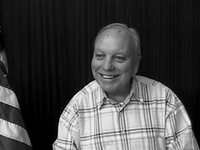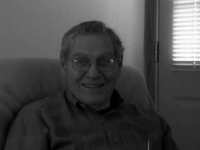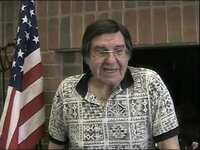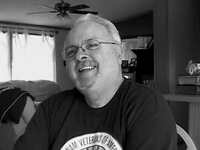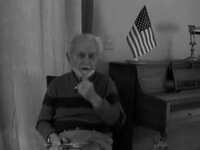Search
113 items
-
Robert Colley was born in Petoskey, Michigan. He was drafted in November 1943, and went to Camp Blanding, just outside Jacksonville, Florida, to do his basic training. After completing basic training, he was granted 2 weeks leave. His next stop was just outside Boston to another camp. From there, Robert was shipped to England to replace troops who had participated in D-Day. He landed 9 days after D-Day, and was assigned to an armored division. While in Normandy, they were fighting in hedge rows, which were hedges used to help hold the soil. The division couldn’t make much headway because of the hedge rows, and it was only after about six weeks of fighting that they finally broke out of the hedgerows and made their way to Paris. Robert helped liberate Paris four months after his unit landed on European soil. He was captured in Aachen, Germany, when his unit was under the command of a new colonel. They fought their way into a valley, and when they got down there, a German tank was pointed down at them. Out of 139 men, 39 were captured, the rest were wounded or killed during the battle. Robert was taken to Camp 7A, and then transferred to Camp 12A. Eventually, he was brought into East Germany, where they were treated fairly well, although they never really got enough to eat. Most of his captors were soldiers who had been wounded on the western front, so now they served as guards. While at the camp, if they worked on a nearby farm, they were given more to eat, as a reward for working, by the farm owner. Robert worked as a harvester on a sugar beet farm at one point. During the winter of that year, he worked on the railroads, pounding stones underneath the ties to level the track. He could tell that the war was getting more intense, and that the Russians were making headway. From their location, POWs could see the supply trains, people, survivors from the Eastern Front increasing in number every day. There were many wounded coming in as well. A few months later, the POWs heard tanks and artillery getting more pronounced. The next morning, the Russians were outside their camp, sitting on their tanks. The POWs were liberated. Robert’s time as a POW had lasted for 8 months. Many Germans fled their farms as a result of the Russian advance, so he and his fellow POWs took a tractor, and headed for the western front. It took about a week to reach the western front. The POWs got to a river and Russian soldiers helped them cross, to get to the American side. There, the former POWs were directed to a camp, to sign in and give their serial number. They were then taken to Belgium and put on a boat back to the States. Afterwards, they were given a 60-day leave. Robert went down to Miami, and spent about a month there, before being sent to New York. He stayed for about three months in a camp, until an order came down to discharge any POWs, and Robert was discharged. He attended the University of Michigan under the GI bill, and graduated in 1949. Robert specialized in physical education, and he went on to become a stock trader in Ann Arbor. He married in 1950 and retired in 2002. He has two daughters.
-
Mr. Collier initially enlisted in the United States Marine Corps in 1944, but the Second World War ended before he would see combat. Interested in officer candidate school, Mr. Collier would be accepted into the United States Army and into West Point in 1948. Serving three tours of duty in Vietnam, Collier served with both Army Special Forces and the 1st Cavalry Division. After his retirement in 1972, Mr. Collier completed his graduate studies in history, and would teach history at Eastern Michigan University and the University of Michigan for many years.
-
Martha Cothorn was born in a small coal mining town in West Virginia (Besoco). When the mines closed, her family moved to the Detroit area. Her father took a job as a crane operator for Jones and Lockland. After attending grammar and high school in Highland Park, she undertook her nursing training at Hillard, in New Orleans. Martha joined the Army Reserves and received her final two years through the Government, in exchange for three years of active service. Martha's basic training took place at Fort Sam Houston, in Texas. Within nine months of entering active service, she was assigned to the 67th Evacuation Hospital, in Qui Nhon, Vietnam. Eventually, she became Head Nurse in the Medical and Psychiatric Units. The Evacuation Hospital would receive patients directly from the field and attempt to patch them up. Patients would either be returned to their unit or transferred to the Field Hospital in Saigon. Typical patients had hepatitis, malaria, or PTSD. Suicides were not unusual. Martha met her husband in Vietnam. She was eventually transferred to Fort Devens, where she got married. She went into the Reserves after her marriage because her husband, who was in the Diplomatic Service, was assigned to Laos. Southern Cal University had a branch in Seoul, and she was able to get her master’s degree from that unit. Martha spent 30 years in active and reserve service. When she returned to civilian life, she worked at the VA Hospitals in Detroit and Ann Arbor. She has two adult children, both of whom graduated from college and live in other towns. Martha joined the Vietnam Veterans of America when she was in Washington. When she settled in Ann Arbor, she joined the local unit of VVA Post 310, and is currently the president, the first female president of it. Martha has many awards, including the highest non-combat medal, and the Bronze Star. She currently lives in Ann Arbor, Michigan.
-
Claude Curry was born on February 1, 1921. Before the war, he worked on sailboats. When he was twenty, he knew that he was going to be drafted. He did not have a college education. Therefore, he did not receive high enough math scores to get into the Air Corps. He was sent to the 24th Infantry Division. Before leaving the country, Claude was threatened in a racist manner and hit the man responsible. He was sent to Honolulu, Hawaii for infantry training. From there, his division was sent to Saipan. On the first night there, he was sent with other men to set up an ambush. In the middle of the night, another soldier in a separate squad made a noise by mistake. Claude and his fellow soldiers were unable to assist and had to wait until morning to observe the scene. None of the three men could be found, only their dog tags. The next day, Claude was sent out to the foot of a mountain near the ambush site, in order to clear out some caves the enemy was hiding in. During the fight, another soldier stood on Claude's back and shot a flamethrower into the nearby cave. A day or two later, he was ordered to check for bodies. He was relieved of duty due to the traumatizing experience. From Saipan, Claude was ordered to Okinawa for two or three days, during the height of the fighting. After Okinawa, he and 126 other men were sent to an unidentified island nearby. He stayed there for six months. Meanwhile, some of the enemies were located on an adjoining island. Before Claude was ordered to engage the enemy, the war was declared over. During celebrations, a couple of soldiers fired rockets that hit a small cargo ship. A typhoon soon hit the island. Despite orders not to move, Claude went in search of shelter. He went out into the storm and made two miles' progress in four hours, with floodwaters coming up to his waste. After braving the storm, Claude was sent back to Okinawa from November 1945 to April 1946. He was discharged in May of that year, and became a bus driver until he retired at the age of 55.
-
Robert had just finished his second semester at U of M when he was drafted. He was living in Ann Arbor, but he was drafted from Vermont because his parents lived there. On June 22, 1943, a got on the train in VT and traveled to Fort Devens. Robert was very nervous because he had entered a completely new environment and wondered what was in store for him. He was sent to infantry basic training in South Carolina in July 1943 and was there for 13 weeks of training. After completing training, he was selected for the Army Specialized Training Program, which gave additional technical training to soldiers. Robert was sent to the University of Connecticut and enrolled in the basic engineering curriculum. He thought it was a poor choice because he was a liberal arts person, and he wasn’t sure that he would succeed. After six months, the program was scrapped anyway, and Robert was sent to the 78th Infantry Division in Virginia, in the spring of 1944. While in Virginia, he prepared to be sent to Germany. He was assigned to a heavy weapons company and was asked by the Motor Sergeant to drive a jeep for the squad. Robert said yes (it would get him out of all the marching!), and he was very glad that he was selected for this position. In September 1944, he was sent to Fort Dix, New Jersey where he boarded a troop ship. Robert landed in England about 10 days later (just a few months after D-Day). He was in England for a few months, getting equipment together, and by late November he crossed the channel, and landed in France. From France, he headed to Belgium and Germany. On Dec 13, 1944 he experienced his first day of combat. His 78th division was replacing another infantry division that had been in combat since D-Day, and the 78th division was just over the German border in Simmerath, a small farming community, when they experienced fierce fighting. He was not on the front lines. His job was to carry a trailer (behind his jeep) with a machine gun mounted on it. On the first day, he was ordered to carry ammunition up to a front-line post. As he was carrying them, a mortar landed nearby, and he caught a small bit of shrapnel in his arm and leg. When Robert arrived at the post, the aid man noticed that he had blood on his arm. Robert was told to go to the aid station to record the wound, receive treatment, and receive a purple heart. The doctors could not find the shrapnel in his arm, so he was sent to Paris for more treatment. He was away from the front for about 45 days. By the time he got back to his company in Germany, many of his comrades had been killed, captured, and wounded. Most of the company was made up of new people, strangers to him. His company had held the northern flank of the Battle of the Bulge, and he resumed his job as a jeep driver. In early March, his company moved south; they were the second infantry division to cross the Rhine River. They entered the Ruhr Valley in early April, within a few weeks of victory in Europe. Robert never fired a weapon in combat, since he was a driver. He thinks he was very fortunate to have fared so well, since he did not have to be at the front. Just after Victory in Europe day, his division came across a Prison camp (not a concentration camp, but a prison labor camp), and they liberated it. After the war ended, they ended up in a holding area, in central Germany and thought that they would be sent to the Pacific Theatre. Instead, his division was picked for occupation duty in Berlin. From October 1945 to March 1946, he was on occupation duty in Berlin with his division. Robert became a clerk for a few months, which he liked better than driving a jeep. In March 1946, he was discharged and sent home. He returned to VT, but his father had died while he was away. Robert worked that summer in Vermont, and then went back to Ann Arbor in September 1946, to finish at U of M with a degree in Psychology.
-
Mr. Davison was drafted into the United States Army in March of 1943. Mr. Davison was known as a "Point Man" within the Army, it was his responsibility to be at the front or "point" of any engagement. At one point during his service in Western Europe, Mr. Davison was shot in the arm and captured by German forces. Considered a prisoner of war and injured, Davison was taken to the Stalag 2-B installation. Mr. Davison recalls in this interview the horrific conditions in which he lived for five months in German custody, and how he believed himself to have no hope. He and many of the other POW's he was with, describe how grateful they were for being liberated by American forces.
-
Herman Deal was born in rural Georgia, in 1923. After completing high school, he took a job building ships. After a year, Herman and his buddies enlisted in the Air Corps, because they were promised that they would be together there. That lasted only a few weeks before they were separated in different training programs. His training took him to Boston, Texas, and the Willow Run plant in Michigan where the B-24s were built. This is where he met his future wife, Helen. Herman learned everything there was to learn about the B-24, including how to pilot the plane. He became the third (emergency) pilot of one. Herman's plane was shot down by very heavy flak on his first mission, to attack a submarine base at Toulon. After he was captured, Herman occupied himself with useful activities, including attending classes, for which he eventually received 18 college credits. Herman's camp was in Austria, but when the Russians began getting close, the entire camp population marched through Germany to Lenz, in the so-called 600-mile death march. His group was finally liberated by the 3rd Armored Division, in Patton's group. After returning to civilian life, Herman became involved in several successful businesses. Today, he and his wife of more than sixty years live in Ann Arbor. Although he is "retired," he works every day. Herman has been honored as one of 21 successful business people in Ann Arbor.
-
Kenneth was born in Dearborn, Michigan, on July 11, 1945, and grew up in Lincoln Park, Michigan. After finishing high school, he worked in a supermarket. Kenneth was drafted in 1965, and after basic training at Fort Knox, Kentucky and advanced training at Fort Lewis, Washington, Kenneth was shipped to Vietnam. His division went as a unit. The trip took 29 days, and at times the weather was very rough, with there even being a typhoon. The division's first location was Tuy Hoa, where they spent four months. They were then sent to Pleiku, near the Cambodian border. Kenneth described having experienced heavy fighting in both locations. He received his first Purple Heart on May 1, 1967 because of shrapnel, and his second exactly one month later. "Friendly Fire" caused deafness when an artillery shell exploded near his location. Although Kenneth served near and next to soldiers who were exposed to Agent Orange, he has been found to have not had any symptoms to this day. Kenneth returned to his supermarket job after his military service, but he eventually went to school to study accounting. His specialty was payroll, and he ended up working for several different companies. Because of his multiple injuries, he retired in 2001. Since his retirement, Kenneth has been a volunteer at local schools. He was married for 39 years, divorcing in 2010. Kenneth talked a great deal about his "blood brother," with whom he pledged to "trade" blood if or when needed. His unit has a reunion every two years. This year, the reunion will be in Tennessee, and in 2012 the reunion will be in Washington, D.C. He is looking forward to visiting Washington, D.C., since he has never had the opportunity to visit the various military memorials there.
-
Joseph is from Michigan and was in the Civilian Conservation Corps (CCC), in the Upper Peninsula. He was drafted in August 1943, but the army let him finish high school before he entered the service. Joseph was sent to Fort Benning for training when he was around 20 years old. He had only 13 weeks of training before going to school at the University of Wisconsin-Madison and was there for several weeks of engineering training. Joseph failed on purpose, so that he would be able to join the army immediately, rather than after college training. He joined the 104th Howling Timberwolves at Camp Carson, in Colorado, for training until they went overseas. They trained at night and were known as “Night-Fighters.” Joseph only fought in one daylight battle while overseas. He landed in Normandy 3 months after D-Day (D-Day+90). The 104th moved through France and into Belgium. Three days later, they received orders to get ready to fight in Holland, where they fought to free the port of Antwerp. Next, the 104th crossed into Germany over the Roer/Rur River to Aachen, to assist the 1st division. Joseph was in a mortar battalion, and was a squad leader, although he was never formally recognized as such. Another squad leader didn’t like him and denied knowing him when asked. Joseph’s unit spent 195 days in constant combat with Germans. This combat took place from Holland down to Aachen, and until the war’s end. He only fought 120 of the days, because he was wounded. Shrapnel from a shell hit him, and he lay for eight hours, waiting for rescue. He was put on a train to Paris, and then to England. He woke up in a hospital in Oxford. He stayed there for three months while he recovered. He was finally sent back to the States, and he arrived in southern California, where he was discharged. After his discharge in 1946, he attended Michigan State University, and worked for GM and Chrysler, as a quality control manager. His unit, the 104th, has had a reunion every labor-day weekend since 1946.
-
Timothy Driscoll was born on Staten Island, New York on July 5, 1945. His father was a chef, and the family moved a great deal. This resulted in Tim attending more than 20 schools before graduating from high school. Tim worked three jobs after high school, and was drafted in 1965, entering the service at Fort Lee, New Jersey. The barracks floors were so corroded that they collapsed. Since Tim had worked on floors in civilian life, he told the sergeant that he could fix them. Before long, there were ample supplies available to Tim to reconstruct the floors. Doing this kept him out of parades and exercise sessions. He was transferred to Fort Leonard Wood, where the weather was extremely cold. Here again, Tim's suggestions changed the way that things were done in the field. Instead of coffee breaks, he had suggested hot soup, which helped personnel cope with the weather. Tim completed the obstacle course so quickly that the sergeant sent him through again and again. Everyone expected to go to Vietnam and was prepared. At the very last minute, however, Tim and two others were taken off the truck. He spent the next 100 days driving officers and officials around. Tim’s training had been in radio and truck and jeep maintenance. He was an E-4 Specialist and became assigned to the 3rd Armored Division. He achieved a Marksman Award and a Good Conduct Award while in the service. Tim was eventually sent to Germany. He spent 17 tense months in Germany. He was discharged in 1967 and returned home. His division received a Presidential Citation. After leaving the service, he got married, and was living in New Jersey when the Twin Towers were destroyed. Tim's son and wife worked in and near the Towers. Both could have been killed were it not for pure luck. Tim’s job required him to travel frequently. By mistake, his wife took his car keys, and had to turn around, and return home. Tim's son was working on the 35th floor of the Towers, but at the time that the plane hit, he was in the basement getting supplies. The family moved to Connecticut, but within a few months his wife was laid off. These events convinced Tim and his family to move to Saline, Michigan, where he now lives with his wife. His daughter lives nearby with her two children.
-
Mr. Elbert was drafted into the United States Army in 1944. After completing basic training, Mr. Elbert was sent to join Allied Forces fighting for control of the Italian Peninsula. After reaching Naples, Elbert was wounded by shrapnel fire coming from German soldiers fighting in Italy. He would later be awarded the Purple Heart for his service in Italy.
-
After graduating from Wayne University (now Wayne State University) with both a bachelor's and Master of Arts degrees in Detroit, Michigan, Mr. Eliot enlisted in the United States Army Air Corps. Trained as a bomber pilot for the B-24 bomber, Eliot would be sent to England where he would fly bombing missions into Nazi-occupied Europe. Eliot was shot down by German forces, and would go on to serve 18 months as a POW. At some point the German soldiers of the installation he was assigned to became aware that Mr. Eliot was Jewish and was made to wear a star with the word "Juden" on it. Following his liberation by American forces, Eliot would return to Metro Detroit to serve as the long-time weatherman for WWJ.

